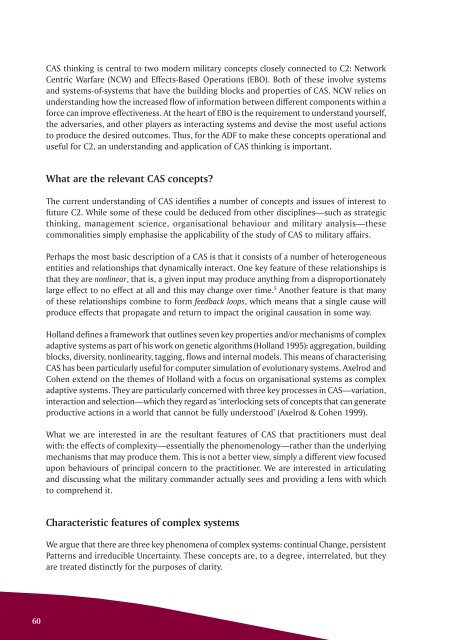ISSUE 176 : Jul/Aug - 2008 - Australian Defence Force Journal
ISSUE 176 : Jul/Aug - 2008 - Australian Defence Force Journal
ISSUE 176 : Jul/Aug - 2008 - Australian Defence Force Journal
You also want an ePaper? Increase the reach of your titles
YUMPU automatically turns print PDFs into web optimized ePapers that Google loves.
CAS thinking is central to two modern military concepts closely connected to C2: Network<br />
Centric Warfare (NCW) and Effects-Based Operations (EBO). Both of these involve systems<br />
and systems-of-systems that have the building blocks and properties of CAS. NCW relies on<br />
understanding how the increased flow of information between different components within a<br />
force can improve effectiveness. At the heart of EBO is the requirement to understand yourself,<br />
the adversaries, and other players as interacting systems and devise the most useful actions<br />
to produce the desired outcomes. Thus, for the ADF to make these concepts operational and<br />
useful for C2, an understanding and application of CAS thinking is important.<br />
What are the relevant CAS concepts?<br />
The current understanding of CAS identifies a number of concepts and issues of interest to<br />
future C2. While some of these could be deduced from other disciplines—such as strategic<br />
thinking, management science, organisational behaviour and military analysis—these<br />
commonalities simply emphasise the applicability of the study of CAS to military affairs.<br />
Perhaps the most basic description of a CAS is that it consists of a number of heterogeneous<br />
entities and relationships that dynamically interact. One key feature of these relationships is<br />
that they are nonlinear, that is, a given input may produce anything from a disproportionately<br />
large effect to no effect at all and this may change over time. 5 Another feature is that many<br />
of these relationships combine to form feedback loops, which means that a single cause will<br />
produce effects that propagate and return to impact the original causation in some way.<br />
Holland defines a framework that outlines seven key properties and/or mechanisms of complex<br />
adaptive systems as part of his work on genetic algorithms (Holland 1995): aggregation, building<br />
blocks, diversity, nonlinearity, tagging, flows and internal models. This means of characterising<br />
CAS has been particularly useful for computer simulation of evolutionary systems. Axelrod and<br />
Cohen extend on the themes of Holland with a focus on organisational systems as complex<br />
adaptive systems. They are particularly concerned with three key processes in CAS—variation,<br />
interaction and selection—which they regard as ‘interlocking sets of concepts that can generate<br />
productive actions in a world that cannot be fully understood’ (Axelrod & Cohen 1999).<br />
What we are interested in are the resultant features of CAS that practitioners must deal<br />
with: the effects of complexity—essentially the phenomenology—rather than the underlying<br />
mechanisms that may produce them. This is not a better view, simply a different view focused<br />
upon behaviours of principal concern to the practitioner. We are interested in articulating<br />
and discussing what the military commander actually sees and providing a lens with which<br />
to comprehend it.<br />
Characteristic features of complex systems<br />
We argue that there are three key phenomena of complex systems: continual Change, persistent<br />
Patterns and irreducible Uncertainty. These concepts are, to a degree, interrelated, but they<br />
are treated distinctly for the purposes of clarity.<br />
60

















